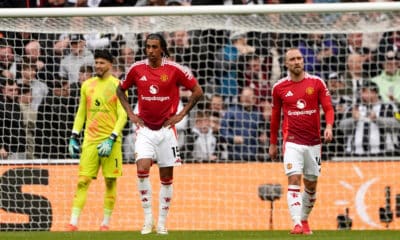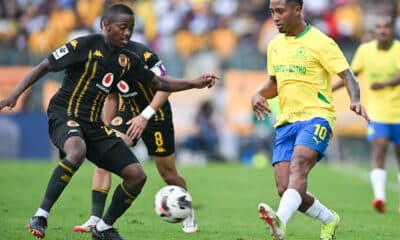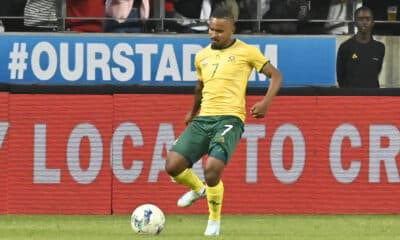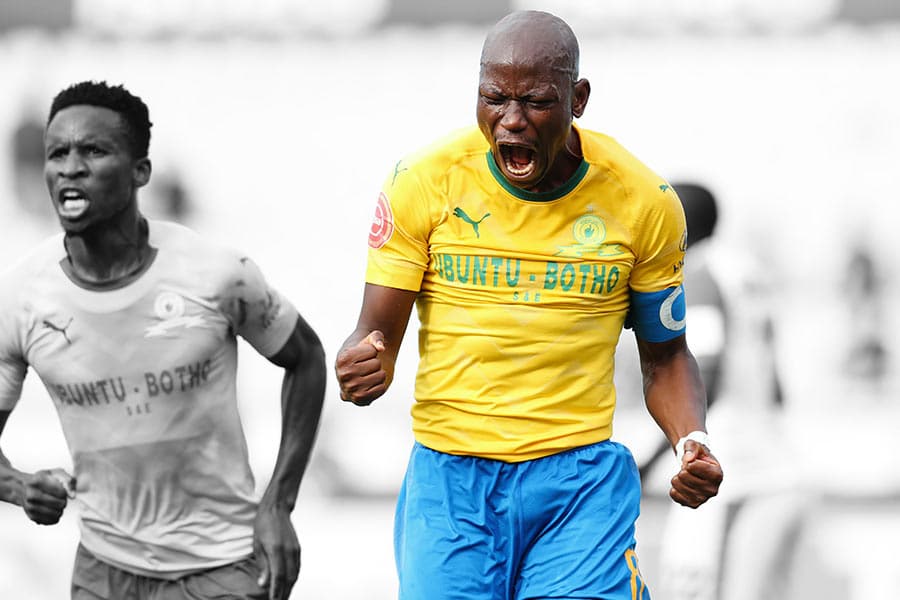
2 August 2019, by: Laduma Analytics
LADUMA ANALYTICS: CAN SUNDOWNS MAKE IT 3 PSL TITLES IN A ROW?AGAIN?
Mamelodi Sundowns head into the new PSL season chasing a third-straight league title. Laduma Analytics breakdown the tactics, squad and season ahead for Masandawana.
When Sundowns step out onto the Lucas Moripe Stadium on Saturday to play SuperSport United, they will be aiming to lift a third straight PSL title. There have only been two teams (Mamelodi Sundowns & SuperSport United) to have achieved that honour – the last of these coming for SuperSport United over a decade ago.
Laduma Analytics took a look into their previous and pre-season preparations to determine the likelihood of this occurrence. First off, it is worth examining the attacking and defensive output of “The Brazilians”.
They scored nine fewer goals in 2018/2019 than in 2017/18. Most of these can be attributed to the departure of striker Percy Tau (11) and team-mate Khama Billiat (8) while defensively they conceded the same tally as the last term. As such, that they were less threatening going forward which was of no surprise.
Using a method such as Expected Goals (xG), we can evaluate and examine their 2018/19 season and how they may need to adjust their attack and defence for the season ahead. xG is used to measure the quality of a shot based on several variables such as distance from goal, angle, assist and type of shot to name a few.
Adding these up throughout a series of games/over the course of a season, we can determine how sustainable the performance of a team may be. Take, for example, their attack; 40 goals throughout the campaign, when based on the chances they had, we would have expected them to score around 43 goals.
We profiled a few forward options later on, yet this tally had to be considered disappointing for the club. The interesting situation with Sundowns is that with the system they played, the goals came from a variety of different players. This is in no shape or form, an issue directly, but rather an adjustment they had to make based on the personnel at Mosimane’s disposal.
On the other hand, their defence or expected goals against (xGA) had a greater difference to how many goals they actually conceded versus expectations. With a solid defensive system and players such as Ricardo Nascimento in their line-up, Sundowns were expected to concede
around 30 goals (on average 1 per game) when they actually conceded just 24. This goal difference of 6 fewer goals conceded is difficult to explain with many factors to consider.
Did they allow fewer chance creation and shooting options from less dangerous situations, was it down to how the team was set-up or were they to an extent “lucky” with the conversion rate of the opposition, just to name a few? xG as a method has its caveats whilst simultaneously
having been scrutinised by coaches, fans and pundits alike. It is a topic we will examine further in the future.
Sundowns will again go into another season as the oldest squad (average 29 years of age) of all PSL teams. The closest PSL team to them are Wits with an average of 28 years of age.
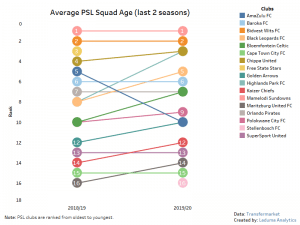
While the squad on average has gotten older, is not directly correlated to how the squad was used by Mosimane. The following graph will show us just how much he fielded “the older generation” versus the up and coming youngsters.
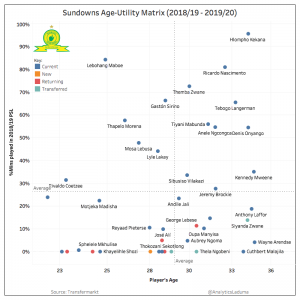
The matrix shows the aggregation of minutes given to players, relative to their ages. We can see how the likes Kekana and Nascimento (in the top right corner) played a lot of football last season, yet these are players who would be considered closer to retirement than their peak.
Mosimane utilised a core group of trusted players in last season’s successful campaign. Ten players featured in more than 50% of the time available. Yet, of that trusted ten, most of them (7) were above Sundown’s average age, with Sirino just below.
Featuring in 96% of minutes available, Hlompo Kekana was the mainstay for Masandawana throughout last season’s victorious title campaign. It is no wonder then, that many Bafana Bafana fans wanted to see more of his involvement in the recently ended AFCON finals tournament. He led his team in minutes played on his way to securing the Midfielder of the Season awards. In fact, of all the league players that featured in at least 85% of their team’s games, Kekana was the oldest.
Overall, Sundowns are not a youth-reliant side, with a paltry 1513 minutes given to players under the age of 23. Only Leopards (1367) and Wits (904) gave fewer minutes to young players throughout all of last season.
Last season, Sundowns relied heavily on two aspects on their way to back-to-back titles. Firstly, they stuck with Mosimane’s preferred tactical formation of 4-4-2 with a double 6 (alternatively also often switching to 4-2-2-2) which essentially changed him to also playing an attack-minded 4-2-3-1. At the heart of this team was captain Kekana (34) and Mabunda (31), who both played 96% and 56% of the available minutes whilst Andile Jali (29) and at times, Coetzee (22) were also utilised.
Before we look at comparing players against each other using radar charts, we have to ‘normalise the data’. What does this mean? As players play a different number of minutes a season, we must weight the data equally for ‘his/her time’ on the pitch. We will not go into much more detail than that – if you are interested in learning about this method, click this link.
When we look at the radar charts below, we begin to understand the roles of Kekana and Mabunda in Sundowns double six midfield system. It is fair to say that tackling and intercepting the ball was an aspect of both their games (one should at least expect this). The fascinating difference between the two was the ‘roles’ they essentially had. Kekana was more fixed on the distribution and seeing the run of team-mates whereas Mabunda was near dominant in intercepting and recovering the ball. It’s just as if Sundowns had a specific system of play at hand.
Unfortunately, it is not all good news. Both are nearing the end of their careers and essentially becoming ‘average PSL players’ – apparent by the radar visual, especially for Kekana. Becoming ‘average’ is by no means the end of the road – however one will have to question – 1) how long do Sundowns play this game of trust and loyalty, 2) can a title-winning team rely on average players and 3) how much game time will he receive in 2019/20?
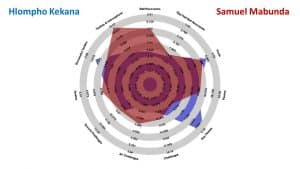
For the times, where Mabunda did not play alongside his captain, Andile Jali was a perfect replacement, doing both jobs simultaneously. However, he is also no longer the youngest at 29 years of age.
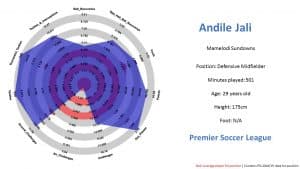
A focus on attack will be at the heart of many Sundowns supporters as their current options performed poorly last season – in terms of shooting, conversion and chance creation. They certainly helped their team out in many other ways through assisting in play, runs off the ball and so forth.
The primary purpose of your forward line is to score goals, yet when these players do not even attempt to shoot or do but from ‘poor’ locations, it will only hurt you one way. Yes, Sundowns can and have played without a recognised centre-forward at times – one would still expect a team en route to defend the championship to create and convert high-quality chances.
Also, research for the Top 5 leagues in Europe has shown that the ability for forwards to create shots is on a falling decline when they hit around 27/28 years of age.
Example A: Gaston Sirino
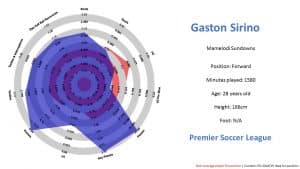
Sirino: An inside forward who was heavily involved in connecting Sundowns play through creating chances and assists with minimal shooting attempts. Of these attempts, the quality (xG per shot) of them were well below an average PSL forward.
Example B: Lebogang Maboe
Predominantly more of a ‘attacking midfielder’ than a straight out ‘forward’, he also got involved in play, although not to the extent of Sirino. Instead, he pressured the opposition on and off the ball through tackles and ball recoveries.
Directly or indirectly, he also struggled to get his shots off, nonetheless, they were of a higher quality than Sirino. If both (with the addition of Affonso) took their chances from higher quality areas of the pitch (xG per shot), their chance at a greater goal tally would be much higher than last season.
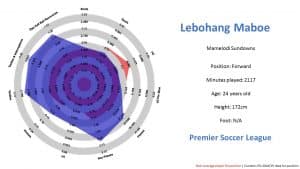
To help achieve that elusive three-in-a-row Sundowns have acquired just one new player this winter – centre-forward Mauricio Affonso (27). Affonso comes to “The Brazilians” from Peru’s First Division having scored 4 goals from 8 appearances.
How his form, style of play and league strength translates over the PSL will be interesting to see. Will he be able to hit the ground running when given the chance? Other additions, saw the return of players from loan spells in the PSL (Sibusiso Khumalo (DM; 28), Luis Miquissone (CAM; 24), George Lebese (LW; 30), Katlego Otladisa (RW; 22) and Thokozani Sekotlong (CF; 28).
Whether Sundowns recruitment was well-thought-out or not, only time will tell. Having the oldest squad will help with ‘experience’, yet their season is considerably longer than many other PSL teams’. We believe that the midfield set-up will be key in determining how they will play throughout the season.
Does Mosimane adapt his system and allow his attacking players to move on or will defensive duties be spread across the full XI? Elsewhere, based on their recruitment strategy and minutes given to players, it is quite apparent that Sundowns buy players for immediate success whilst continuously building a team of ‘youngsters’ to shape for the future.
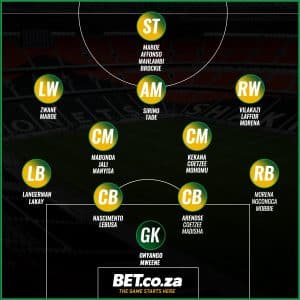
MORE SOCCER
















